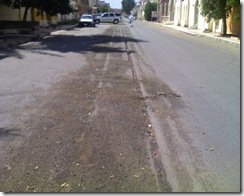Lane markings
 The first thing one has to realise when driving is that the various lane markings that may or may not appear on various road surfaces are an after thought and should not be followed strictly. Strictly following a lane increases your chances of having a collision. The faulty assumption is that the other drivers on the road follow the lane markings. The key to driving on the various roads is to keep one’s peripheral vision trained on the bonnet of the car on your side and its proximity to your door. Keep this distance a constant and watch out for rapid manouvres especially near slowing traffic. Perhaps it is the slowing traffic though I am not sure this is the only factor, certain drivers are clearly mesmerised by the road ahead and think they are driving a snake rather than a car and attempt to slither through the traffic.
The first thing one has to realise when driving is that the various lane markings that may or may not appear on various road surfaces are an after thought and should not be followed strictly. Strictly following a lane increases your chances of having a collision. The faulty assumption is that the other drivers on the road follow the lane markings. The key to driving on the various roads is to keep one’s peripheral vision trained on the bonnet of the car on your side and its proximity to your door. Keep this distance a constant and watch out for rapid manouvres especially near slowing traffic. Perhaps it is the slowing traffic though I am not sure this is the only factor, certain drivers are clearly mesmerised by the road ahead and think they are driving a snake rather than a car and attempt to slither through the traffic.In general ignore the lane markings and aim to keep the distance between your car and the one next to it constant. On big roads this is easiest to do on the outside or fast lane. On roads within the city it is best to stick to the middle of the road. The advantage of doing this is soon realised within a few days of driving around. Usually in countries where driving rules are better followed feeder roads joining a main road have a give way sign and cars slow down or stop and wait for the main road to be clear before joining. Here it is quite common practice for cars to swing onto the main road with little regard for what is coming down the main road. It is is assumed that the inside lane (furthest away from the other side) is always empty. Sticking like a good driver to the slow inside lane will increase your chances dramatically of being hit sooner or later by a car.
The outside lane, is also a bit of a headache within the cities. Most of the large cities have a one way system, with the occasional ‘U’ turns which allow cars to change lanes. When cars wish to change their direction they use these U turns to turn around, unfortunately nobody seems to have realised that the cars entering the U turn are in the outside or fast lane of the large roads. As you are merrily driving down you may suddenly notice that the large queue of cars in front of you are actually stationery and not moving. Be prepared to hit the brakes though not too sharply as drivers tend not to observe the car in front that carefully.
One of the often used ‘cheat sheet’ methods at a ‘U’ turn is to come on the middle lane upto the ‘U’ past the long queue of cars trying to turn and then take a left into the ‘U’ turn, watch out out for this maneouvre when driving in the middle lane.
On smaller roads where the roads are not one way, the going and coming lanes are further blurred and it is not an uncommon sight to see a car venturing down the ‘wrong’ side of the road. The best policy in these situations is to slow down rather than choose the wrong lane and allow the approaching car to whizz around you. Most drivers in these parts tend to think they can whizz around any barriers like a fly zooming around someone’s head, unfortunately when both drivers heading in opposite directions have this mentality it tends to lead to mid-road collisions.
Other lanes that you may not realise but do exist especially on the various highways are the service lane on the inside and the patch of desert on the outside. Both are used quite often as traffic density increases especially on the way to popular destinations such as Makkah. If you happen to look in the rear view mirror and see a cloud of dust coming up on the outside lane, that is usually someone driving faster than everyone in the outer lane but along the desert track. Other places where an extra lane is squeezed out is the small gap between the outside lane and the crash barrier on the Jeddah-Makkah highway. It is a daily sight to find people flashing away at the car in front and overtaking squeezing through gap between the cars in the outside lane and the crash barrier. In such conditions miscalculations are not infrequent and it is best to avoid this outer lane when traffic is moving at high speed, in particular on the Jeddah Makkah highway.
Next post, God willing, will be on the art of round abouts.
No comments:
Post a Comment